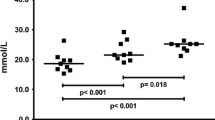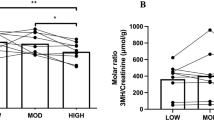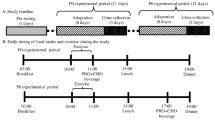Abstract
This investigation was designed to evaluate changes in plasma and muscle levels of free amino acids during an ultra-endurance exercise and following recovery. Nine male ultra-endurance trained athletes participated in a 24-h standardized endurance trial with controlled energy intake. The participants performed 12 sessions of running, kayaking and cycling (4 × each discipline). Blood samples were collected before, during and after exercise, as well as after 28 h of recovery. Muscle biopsies were taken before the test and after exercise, as well as after 28 h of recovery. During the 24-h exercise, plasma levels of branched-chain (BCAA), essential amino acids (EAA) and glutamine fell 13, 14 and 19% (P < 0.05), respectively, whereas their concentrations in muscle were unaltered. Simultaneously, tyrosine and phenylalanine levels rose 38 and 50% (P < 0.05) in the plasma and 66 and 46% (P < 0.05) in muscle, respectively. After the 24-h exercise, plasma levels of BCAA were positively correlated with muscle levels of glycogen (r 2 = 0.73, P < 0.05), as was the combined concentrations of muscle tyrosine and phenylalanine with plasma creatine kinase (R 2 = 0.55, P < 0.05). Following 28-h of recovery, plasma and muscle levels of amino acids had either returned to their initial levels or were elevated. In conclusion, ultra-endurance exercise caused significant changes elevations in plasma and muscle levels of tyrosine and phenylalanine, which suggest an increase in net muscle protein breakdown during exercise. There was a reduction in plasma concentrations of EAA and glutamine during exercise, whereas no changes were detected in their muscle concentration after exercise.




Similar content being viewed by others
References
Ahlborg G, Felig P, Hagenfeldt L, Hendler R, Wahren J (1974) Substrate turnover during prolonged exercise in man. Splanchnic and leg metabolism of glucose, free fatty acids, and amino acids. J Clin Invest 53:1080–1090
Andersen JL, Aagaard P (2000) Myosin heavy chain IIX overshoot in human skeletal muscle. Muscle Nerve 23:1095–1104
Astrand PO, Rodahl K (1986) Textbook of work physiology: physiological bases of exercise. McGraw Hill, New York
Blomstrand E, Saltin B (1999) Effect of muscle glycogen on glucose, lactate and amino acid metabolism during exercise and recovery in human subjects. J Physiol 514(Pt 1):293–302
Danieli Betto D, Zerbato E, Betto R (1986) Type 1, 2A, and 2B myosin heavy chain electrophoretic analysis of rat muscle fibers. Biochem Biophys Res Commun 138:981–987
Decombaz J, Reinhardt P, Anantharaman K, von Glutz G, Poortmans JR (1979) Biochemical changes in a 100 km run: free amino acids, urea, and creatinine. Eur J Appl Physiol Occup Physiol 41:61–72
Dempster P, Aitkens S (1995) A new air displacement method for the determination of human body composition. Med Sci Sports Exerc 27:1692–1697
Dill DB, Costill DL (1974) Calculation of percentage changes in volumes of blood, plasma, and red cells in dehydration. J Appl Physiol 37:247–248
Enqvist JK, Mattsson CM, Johansson PH, Brink-Elfegoun T, Bakkman L, Ekblom BT (2010) Energy turnover during 24 hours and 6 days of adventure racing. J Sports Sci 28:947–955
Fernstrom M, Bakkman L, Tonkonogi M, Shabalina IG, Rozhdestvenskaya Z, Mattsson CM, Enqvist JK, Ekblom B, Sahlin K (2007) Reduced efficiency, but increased fat oxidation, in mitochondria from human skeletal muscle after 24-h ultraendurance exercise. J Appl Physiol 102:1844–1849
Graham TE, Turcotte LP, Kiens B, Richter EA (1995) Training and muscle ammonia and amino acid metabolism in humans during prolonged exercise. J Appl Physiol 78:725–735
Haralambie G, Berg A (1976) Serum urea and amino nitrogen changes with exercise duration. Eur J Appl Physiol Occup Physiol 36:39–48
Hargreaves MH, Snow R (2001) Amino acids and endurance exercise. Int J Sport Nutr Exerc Metab 11:133–145
Henriksson J (1991) Effect of exercise on amino acid concentrations in skeletal muscle and plasma. J Exp Biol 160:149–165
Howarth KR, Phillips SM, MacDonald MJ, Richards D, Moreau NA, Gibala MJ (2010) Effect of glycogen availability on human skeletal muscle protein turnover during exercise and recovery. J Appl Physiol 109:431–438
Huq F, Thompson M, Ruell P (1993) Changes in serum amino acid concentrations during prolonged endurance running. Jpn J Physiol 43:797–807
Jackman ML, Gibala MJ, Hultman E, Graham TE (1997) Nutritional status affects branched-chain oxoacid dehydrogenase activity during exercise in humans. Am J Physiol 272:E233–E238
Kingsbury KJ, Kay L, Hjelm M (1998) Contrasting plasma free amino acid patterns in elite athletes: association with fatigue and infection. Br J Sports Med 32:25–32; discussion 32–33
Koopman R, Pannemans DL, Jeukendrup AE, Gijsen AP, Senden JM, Halliday D, Saris WH, van Loon LJ, Wagenmakers AJ (2004) Combined ingestion of protein and carbohydrate improves protein balance during ultra-endurance exercise. Am J Physiol Endocrinol Metab 287:E712–E720
Leighton B, Blomstrand E, Challiss RA, Lozeman FJ, Parry-Billings M, Dimitriadis GD, Newsholme EA (1989) Acute and chronic effects of strenuous exercise on glucose metabolism in isolated, incubated soleus muscle of exercise-trained rats. Acta Physiol Scand 136:177–184
Mattsson CM, Enqvist JK, Brink-Elfegoun T, Johansson PH, Bakkman L, Ekblom B (2010) Reversed drift in heart rate but increased oxygen uptake at fixed work rate during 24 h ultra-endurance exercise. Scand J Med Sci Sports 20:298–304
Mourtzakis M, Saltin B, Graham T, Pilegaard H (2006) Carbohydrate metabolism during prolonged exercise and recovery: interactions between pyruvate dehydrogenase, fatty acids, and amino acids. J Appl Physiol 100:1822–1830
Newsholme EA, Leech TR (2010) Functional biochemistry in health and disease. Wiley-Blackwell, Chichester
Nosaka K, Clarkson PM (1996) Variability in serum creatine kinase response after eccentric exercise of the elbow flexors. Int J Sports Med 17:120–127
Parry-Billings M, Budgett R, Koutedakis Y, Blomstrand E, Brooks S, Williams C, Calder PC, Pilling S, Baigrie R, Newsholme EA (1992) Plasma amino acid concentrations in the overtraining syndrome: possible effects on the immune system. Med Sci Sports Exerc 24:1353–1358
Pfeifer R, Korpi J, Burgoyne R, McCourt D (1983) Practical application of HPLC to amino acid analyses. Am Lab 15:77–84
Rennie MJ, Edwards RH, Krywawych S, Davies CT, Halliday D, Waterlow JC, Millward DJ (1981) Effect of exercise on protein turnover in man. Clin Sci (Lond) 61:627–639
Tarnopolsky M (2004) Protein requirements for endurance athletes. Nutrition 20:662–668
Tee JC, Bosch AN, Lambert MI (2007) Metabolic consequences of exercise-induced muscle damage. Sports Med 37:827–836
van Hall G, MacLean DA, Saltin B, Wagenmakers AJ (1996) Mechanisms of activation of muscle branched-chain alpha-keto acid dehydrogenase during exercise in man. J Physiol 494(Pt 3):899–905
Weir JB (1949) New methods for calculating metabolic rate with special reference to protein metabolism. J Physiol 109:1–9
Acknowledgments
The authors wish to sincerely thank our courageous participants and gratefully acknowledge the valuable contributions made by the supporting staff involved in the experiment. This study was supported financially by grants from the Swedish National Centre for Research in Sport and the Swedish School of Sport and Health Sciences.
Conflict of interest
None.
Author information
Authors and Affiliations
Corresponding author
Additional information
Communicated by Susan A. Ward.
Rights and permissions
About this article
Cite this article
Borgenvik, M., Nordin, M., Mikael Mattsson, C. et al. Alterations in amino acid concentrations in the plasma and muscle in human subjects during 24 h of simulated adventure racing. Eur J Appl Physiol 112, 3679–3688 (2012). https://doi.org/10.1007/s00421-012-2350-8
Received:
Accepted:
Published:
Issue Date:
DOI: https://doi.org/10.1007/s00421-012-2350-8




